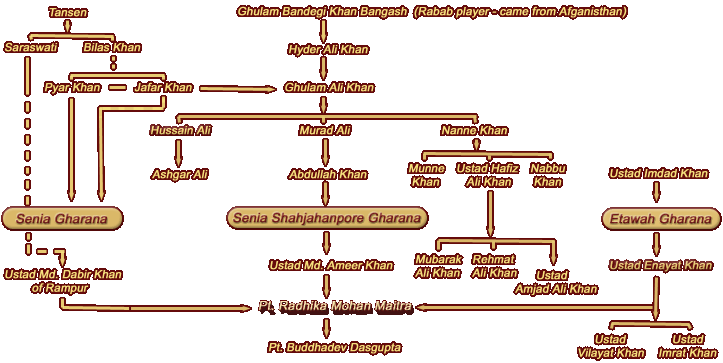 | ||
Tabla lucknow gharana hindustani music
In Hindustani music, a gharānā is a system of social organization linking musicians or dancers by lineage or apprenticeship, and by adherence to a particular musical style. A gharana also indicates a comprehensive musicological ideology. This ideology sometimes changes substantially from one gharana to another. It directly affects the thinking, teaching, performance and appreciation of music.
Contents
- Tabla lucknow gharana hindustani music
- Khyal gharanas
- Dhrupad gharanas
- Thumri gharanas
- Tabla gharanas
- Wind and string instruments
- Sitar gharanas
- Dance gharanas
- References
The word gharana comes from the Hindi word 'ghar' which is derived from Sanskrit for Griha, which means 'house'. It typically refers to the place where the musical ideology originated; for example, some of the gharanas well known for singing khyals are: Agra, Gwalior, Indore, Jaipur, Kirana, and Pattiala.
Khyal gharanas
The gharana system in khyal was rooted in the guru-shishya tradition and was similar to the Dhrupad Bani system. The gharana system was greatly influenced by the gradual fall of the Mughal Empire, which forced musicians to move from Delhi to princely states such as Gwalior, Lucknow, Hyderabad, Patiala and Rampur.
The gharanas have distinct styles of presenting the khyal — how much to emphasize and how to enunciate the words of the composition, when to sing the sthayi and antara, whether to sing an unmetered alap in the beginning, what kinds of improvisations to use, how much importance to give to the rhythmic aspect, and so on. However, an individual performer from a gharana may choose to borrow appealing stylistic aspects of another gharana in his or her gayaki. The prominent khyal gharanas are:
Dhrupad gharanas
Thumri gharanas
In the Benares Thumri Gharana, the words in the text of a song are musically embellished to bring out their meaning, while the Lucknow gharana presents intricately embellished and delicate thumris that are explicit in their eroticism. The principal feature of the thumri of the Patiala gharana is its incorporation of the tappa from the Punjab region. It is with this tappa element that the Patiala gharana makes its impact, departing from the khyal-dominated Benaras thumris and the dance-oriented Lucknow thumris.
Tabla gharanas
The following are the six widely accepted Tabla Gharanas. The prominent Tabla Gharanas are in bold (ordered based on chronology of founding):
Wind and string instruments
Sitar gharanas
Dance gharanas
In Kathak performers today generally draw their lineage from three major schools of Kathak: the Jaipur gharana, the Lucknow gharana and the Banaras gharana (born in the courts of the Kachwaha Rajput kings, the Nawab of Oudh, and Varanasi respectively); there is also a less prominent (and later) Raigarh gharana which amalgamated technique from all three preceding gharanas but became famous for its own distinctive compositions.
The Lucknow gharana remains the most popular throughout the country. However, in recent times the Jaipur gharana has caught up and today most performers throughout India perform techniques belonging to both styles. With amalgamation of the techniques and poses from other dance forms, the purity of the movements and gestures may be diluted or modified along with the contemporary trends.
